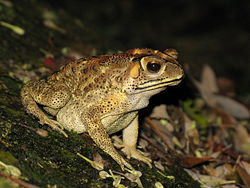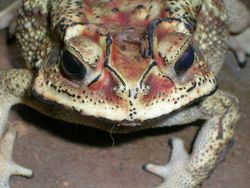- Duttaphrynus melanostictus
-
Common Indian Toad Specimen from Hong Kong. Conservation status Scientific classification Kingdom: Animalia Phylum: Chordata Class: Amphibia Order: Anura Family: Bufonidae Genus: Duttaphrynus Species: D. melanostictus Binomial name Duttaphrynus melanostictus
(Schneider, 1799)Synonyms Bufo melanostictus
The Common Indian Toad or Common Asiatic/Asian Toad or Black-spined Toad Duttaphrynus melanostictus is a species of toad that is common in South Asia. The species grows to almost 20 cm long. The species breeds during the monsoons and the tadpoles are black. Young toads may be seen in large numbers after the monsoons.
Contents
Description
The top of the head has several bony ridges, along the edge of the snout (canthal ridge), in front of the eye (pre-orbital), above the eye (supra-orbital), behind the eye (post-orbital), and a short one between the eye and ear (orbito-tympanic); The snout is short and blunt and the space between the eyes is broader than the upper eyelid width. The ear drum or tympanum is very distinct and is at least as wide as two thirds the diameter of the eye. The first finger is often longer than the second and the toes at least half webbed. A warty tubercle is found just before the junction of the thigh and shank (sub-articular tubercle) and two moderate ones are on the shank (metatarsus). There is no skin fold along the tarsus. The "knee" (tarso-metatarsal articulation) reaches the tympanum or the eye when the hind leg is held parallel along the side of the body. The dorsal side is covered with spiny warts. The parotoids are prominent, kidney-shaped or elliptical and elongated. The dorsal side is yellowish or brownish and the spines and ridges are black. The underside is unmarked or spotted. Male have a subgular vocal sac and black pads on the inner fingers that help in holding the female during copulation.[2]
These toads are often seen at night under street lamps especially during times when winged termites swarm. They have been noted to feed on a wide range of invertebrates including scorpions.[3] Tadpoles grown in sibling groups metamorphosed faster than those that were kept in mixed groups.[4] Tadpoles have been shown to be able to recognize kin.[5]
References
- ^ van Dijk et al. (2004). Bufo melanostictus. 2006. IUCN Red List of Threatened Species. IUCN 2006. www.iucnredlist.org. Retrieved on 12 May 2006.
- ^ Boulenger, G. A. (1890). Fauna of British India. Reptilia and Batrachia.. London: Taylor and Francis. pp. 505–507. http://www.archive.org/stream/reptiliabatrachi1890boul#page/505/mode/1up.
- ^ Berry, P. Y. & J. A. Bullock (1962). "The food of the common Malayan Toad, Bufo melanostictus Schneider". Copeia 4: 736–741.
- ^ Saidapur, S. K. & S. Girish (2001). "Growth and metamorphosis of Bufo melanostictus tadpoles; Effects of Kinship and Density". J. Herpetology 5 (2): 249–254.
- ^ Saidapur, S. K. & Girish (2000). "The ontogeny of kin recognition in tadpoles of the toad Bufo melanostictus (Anura; Bufonidae)". J. Biosci. 25: 267–273.
Further reading
Lu, W., QingN. (2010). Bufo melanostictus (Asian Common Toad). Record size. Herpetological Review 41(1): 61.
External links
- http://www.ecologyasia.com/verts/amphibians/asiatic_toad.htm
- Amphibian and Reptiles of Peninsular Malaysia - Duttaphrynus melanostictus

This Bufonidae article is a stub. You can help Wikipedia by expanding it.








